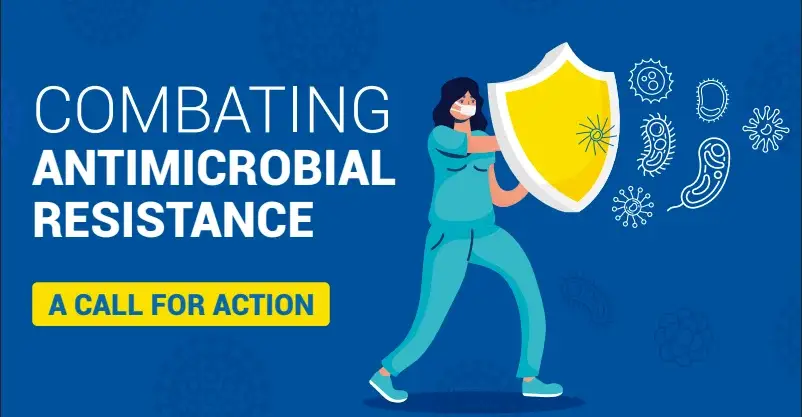Subscribe to get weekly insights
Always stay up to date with our newest articles sent direct to your inbox
Published on 11 Aug, 2025
favorite2Likes
59 Views
4 min Read

Antimicrobial resistance (AMR) is a major global health threat. It has been directly responsible for around 1.27 million deaths in India and contributed to nearly 5 million deaths worldwide.
In addition to death and disability, it also has significant economic costs. The World Bank has estimated that unchecked AMR can lead to healthcare costs rising to an additional $1 trillion by 2050 and $1-3.4 trillion in Global GDP losses annually by 2030.
The alarming statistics on antimicrobial resistance highlights the urgent need to understand this growing health concern. To address this issue effectively, let’s first understand what AMR means and then explore its implications.
____________________________________________________________________________
When humans, animals or plants contract an infectious disease, they are typically treated with antibiotics, antivirals, antifungals or anti-parasitics, depending on the nature of the disease. These broad group of treatments are called antimicrobials since they seek to treat illness caused by an invasion of microbes.
But there are some cases where these useful treatments stop being effective. That’s antimicrobial resistance (AMR). Essentially, in some situations like an incomplete course of medication or over use of antibiotics— the microbes get a chance to adapt, survive and evolve. Over time, only the strongest germs remain and they are no longer as adversely impacted by the treatment. As a result, infections become harder to cure, leading to longer illnesses, complications, and even death.
While resistance is a natural survival tactic for microbes, it’s being dangerously accelerated by human actions—especially the overuse and misuse of antimicrobials. The more carelessly we use them, the faster we lose their beneficial action on infections.
Authorities have been taking measures to prevent the rise of Antimicrobial Resistance. However, knowing what individuals can do to avoid developing AMR will help you to continue to enjoy the healing properties of anti-microbials.
In 2020, Viswanathan - a 58-year-old stroke survivor, sought alternative physiotherapy from an Ayurvedic practitioner to regain mobility. Tragically, the treatment led to severe wounds on his leg. As a diabetic, with a weakened immune system, this opened the door to repeated infections—and resulted in the start of his battle with antimicrobial resistance (AMR).
Over the next year, multiple treatments failed. A powerful, last-resort antibiotic was eventually administered, but it severely damaged his kidneys. Hospital-acquired infections added to his complications and eventually he lost his life.
Viswanathan’s battle with AMR is a stark reminder of the direct and indirect consequences of AMR.
Beyond the immediate threat of AMR, there are several unseen consequences associated with the use of antibiotics.
____________________________________________________________________________
The viral season is closely linked to the development of Antibiotic resistance, largely because we tend to use more antibiotics during this time. Although viral infections cannot be treated by antibiotics, they can weaken the immune system and make us susceptible to bacterial infections (like pneumonia), which do require antibiotics.
This increased and sometimes unnecessary antibiotic use during viral seasons can contribute to antimicrobial resistance (AMR)—as bacteria exposed to antibiotics more frequently are more likely to develop resistance.
Through Hygiene: Maintaining good hand hygiene is essential for individuals. This means consistently washing hands thoroughly with soap and water for at least 20 seconds or using an effective hand sanitizer when soap and water are unavailable.
Through Environment: Regarding environmental cleaning, it's crucial to utilise EPA (Environmental Protection Agency)-registered disinfectants that are proven effective against various micro-organisms and to always adhere to the manufacturer's instructions for proper use.
Through Sterilization: When sterilising medical devices, methods such as dry heat are employed to ensure the complete elimination of micro-organisms, and routine checks and maintenance of equipment are necessary to uphold sterility and functionality.
Through Screening of Patients: Lastly, proper methods should be used while screening patients for resistant infections like MRSA or C. difficile, and if detected with resistant infections, appropriate isolation in a private room is essential for preventing any further spread.
The National Programme on AMR Containment is an initiative by the Indian government to address the growing threat of antimicrobial resistance. Launched during the 12th Five-Year Plan (2012-17), it aims to strengthen surveillance, promote responsible antimicrobial use, and improve infection control practices.
The National Centre for Disease Control (NCDC) coordinates the program and involves multiple stakeholders across various sectors.
Key Objectives:
| Stakeholder | Role in Combating AMR |
| Individuals | Practice good hygiene, get vaccinated, and use antibiotics judiciously |
| Healthcare Providers | Prescribe antibiotics responsibly, educate patients |
| Government | Implement antibiotic stewardship programs, enhance surveillance |
| Pharmaceutical Industry | Develop new antibiotics, improve antibiotic manufacturing |
As we face the challenges during the viral season, remember that controlling AMR is a collective responsibility.
Every thoughtful action, informed decision, and responsible choice brings us closer to a future where antibiotics remain effective.
Let’s harness our collective power to protect public health and promote a safer world.
Every month, we cover topics like this. Stay tuned to receive insightful articles directly in your mailbox!
Till then, share this article with the people you care about.
Stay informed, stay insured.
Team Care Health
References: who.int, amr.gov.au, thehindu.com, pmc.ncbi.nlm.nih.gov, ncdc.mohfw.gov.in
Always stay up to date with our newest articles sent direct to your inbox
Loading...